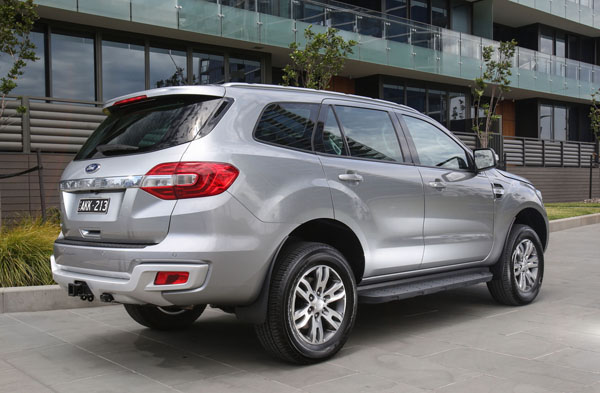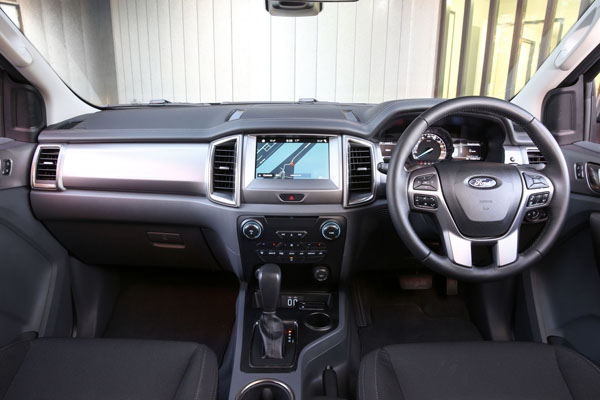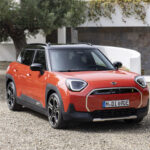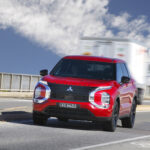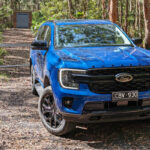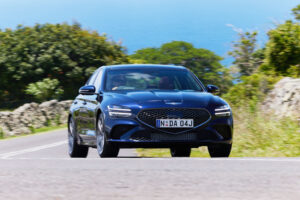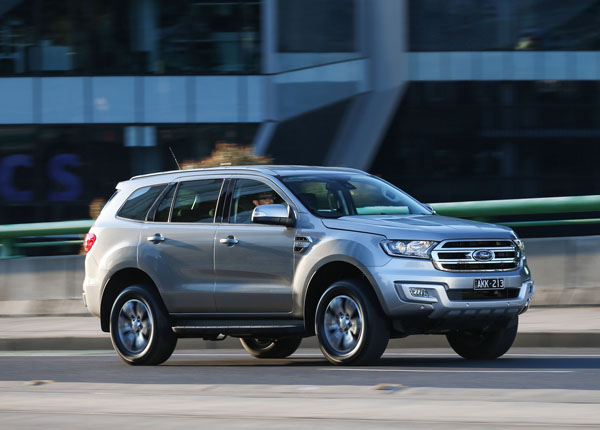 Since the Ford Everest was introduced in 2015, the large SUV has held a steady, if unspectacular, course picking up several 4×4 awards on the way and gaining seven seats as well as five. Also introduced was a rear wheel-drive models for the High Street adventurer.
Since the Ford Everest was introduced in 2015, the large SUV has held a steady, if unspectacular, course picking up several 4×4 awards on the way and gaining seven seats as well as five. Also introduced was a rear wheel-drive models for the High Street adventurer.
Now the Everest is about to hit the big time with the MY19 version taking on a new-generation powertrain which includes a bi-turbo, four-cylinder diesel engine mated with a 10-speed automatic transmission; a raft of the latest safety systems and convenience features, as well as a five-year unlimited kilometre warranty and further service benefits.
Maintaining its three-model line-up of Ambient, Trend and Titanium, pricing ducks below $50,000, with the Ambient rear-wheel drive, and tops out at $73,990, plus on road costs, for the flagship Titanium 4WD seven-seater.
Everest Trend Bi-Turbo, with only a small rise in pricing over the preceding single-turbo model, was on test.
STYLING
Ford Everest’s rugged appearance have all three variants standing their ground with any rival, with the Trend taking on such features as 18-inch alloy wheels and running boards, while the square shaped rear of many traditional SUVs is left behind by Everest’s sculpted tail lamps, with integrated LED lighting.
Trend has switched to new HID headlamps with auto levelling function, LED day-time running lights, plus hands-free power lift tailgate.
INTERIOR
The cabin is a genuine seven-seater. Flexible second-row seats have 60 / 40 split, and power-fold third-row seats with 50 / 50 split, can be folded flat, providing 2010 litres of cargo space with a class-leading payload of up to 750 kg.
Joining the first-time features for Trend are leather accented seat trim (third-row occupants miss out), leather trimmed gear lever and eight-way power driver’s seat with manual lumbar support.
INFOTAINMENT
Brightest feature of the system is the high resolution 8-inch colour touchscreen in the Interior Command Centre, one of the easiest on the market to view and operate. The up-to-date design of the instrumentation cluster, which incorporates dual 4-inch colour screens, is not too shabby also.
Unchanged is an AM/FM/CD audio system with DAB+ digital and 10 speakers, augmented by AUX/iPod/ USB/SD card input ports. SYNC 2 brings voice control with simple commands for many vehicle and convenience systems and emergency assistance connects drivers with emergency responders in a serious collision.
ENGINES / TRANSMISSIONS
The new bi-turbo diesel engine in the Everest Trend and Titanium really is the bees’ knees, pumping out maximum power of 157 kW at 3750 rpm and top torque of 500 Nm between 1750 and 2500 revolutions.
SAFETY
Also debuting on the Everest Trend are pre-collision assist and pedestrian detection with the autonomous emergency braking system and traffic sign recognition.
Carried over are seven airbags, including driver’s knee airbag. Dynamic stability control with roll stability control, ABS anti-skid brakes with electronic brake force distribution, traction control and emergency brake assist are constantly active when on the move.
Parking is made easy with the use of a rear-view camera, plus audible sensors front and rear.
DRIVING
The bi-turbo motor is a delight. Overtaking on the highway is only a matter of easing the accelerator pedal forward and the power needed is presented smoothly and instantaneously, making the sometimes ticklish manoeuvre a breeze.
Gone is the fiddly old-style ignition key; replaced by push-button engine start / stop and new gear shifter. Fuel consumption topped 13 litres per 100 kilometres in mixed traffic conditions and 7.6 litres per 100 kilometres on the highway.
Generous ground clearance (225 mm) and 800 mm wading depth get the Everest ready for anything that might stand in its way off the bitumen.
Shortcomings – short being the operative word – rest with the rear seats, the third row, when in use, offers little head room for an adult and limited legroom even for children, making more than short journeys a chore.
Getting in and out is quite a step up too.
However, occupants have the advantage of dual zone climate control and more than 30 stowage spots totalling 48 litres (the glovebox can take a 16-inch laptop), while sound insulating materials and active noise cancellation technology make for a quiet cabin.
DDDD SUMMARY
Turbo power, 10 speeds, plus significant Australian design, engineering and development, make the Everest, some would say, an irresistible offering.
AT A GLANCE
MODEL LINE-UP
Everest Ambiente RWD 3.2L 6AT five-seat: $49,190
Everest Ambiente RWD 3.2L 6AT seven-seat: $50,190
Everest Ambiente 4WD 3.2L 6AT five-seat: $54,190
Everest Ambiente 4WD 3.2L 6AT seven-seat: $55,190
Everest Trend RWD Bi-Turbo 10AT seven-seat: $56,190
Everest Trend 4WD 3.2L 6AT seven-seat: $59,990
Everest Trend 4WD Bi-Turbo 10AT seven-seat: $61,190
Everest Titanium 4WD Bi-Turbo 10AT seven-seat: $73,990 (incl. Luxury Car Tax)
Options
Third-row seating (Ambiente): $1000
Tow bar (Ambiente and Trend): $1000
Prestige Paint (Ambiente and Trend): $600
Prestige Paint (Titanium): $780
Note: These prices do not include government or dealer delivery charges. Contact your local Ford dealer for drive-away prices.
SPECIFICATIONS (Ford Everest Trend Bi-Turbo 4-cylinder diesel, 10-speed automatic, seven-seat SUV)
ENGINE:
Configuration: Four cylinders in line
Maximum Power: 157 kW @ 3750 rpm
Maximum Torque: 500 Nm @ 1750-2500 rpm
Fuel Type: Diesel
Combined Fuel Cycle (ADR 81/02): 6.9 L/100km (RWD), 7.1 (4WD)
DRIVELINE: Ten-speed automatic with sequential sport shift, RWD / 4WD
DIMENSIONS, WEIGHT AND CAPACITIES:
Length: 4892 mm
Wheelbase: 2850 mm
Width: 2180 mm
Height: 1837 mm
Turning Circle: 11.7 metres
Kerb Mass: 2407 kg
Fuel Tank Capacity: 80 litres
STANDARD WARRANTY:
Five years / unlimited kilometres




